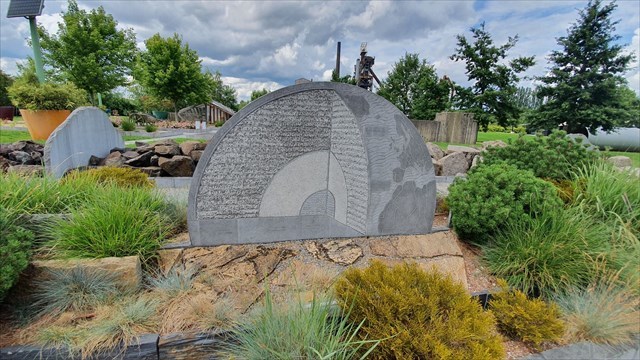 Sur le site du jardin des traces se trouve une sculpture monumentale de Sylvain DIVO qui représente une gravure de la découpe de la terre sur pierre bleue d’Hainaut dimensions 120x190cm. L'accès à ce site est payant ( www.jardindestraces.fr ) il vous permettra une formidable promenade dans les jardins ainsi q'au site du Haut fourneau U4.
Sur le site du jardin des traces se trouve une sculpture monumentale de Sylvain DIVO qui représente une gravure de la découpe de la terre sur pierre bleue d’Hainaut dimensions 120x190cm. L'accès à ce site est payant ( www.jardindestraces.fr ) il vous permettra une formidable promenade dans les jardins ainsi q'au site du Haut fourneau U4.
Je vous propose cette earth cache à l'occasion du Geo'Fourneau elle vous permetra de cécouvrirles strates de notre belle planète et d'en aprendre un peu plus sur la pierre qui est utilisée pour sa représentation.
La pierre bleue d'Hainault est une roche sédimentaire calcaire de couleur bleu gris . Sa particularité est de n’être présente que dans une nervure géologique carbonatée qui traverse la Belgique, les profondeurs de la Manche jusqu’aux îles britanniques,
Elle est constituée de fossiles calcaires d'organismes marins, des crinoïdes cimentés par une boue calcaire. Son origine remonte à 345 millions d’années quand la mer tropicale recouvrait la région
C'est une roche dure et solide, lourde, compacte comme du marbre (mais ce n'est pas un vrai marbre au sens pétrographique, car ce calcaire sédimentaire n'est pas métamorphisé, bien que sa composition, essentiellement de la calcite, et ses caractéristiques techniques soient assez proches du marbre).
Une même pierre peut donner des coloris très différents simplement selon la manière dont sa surface est travaillée : noir, gris clair, bleu-gris, bleu... De manière générale, elle est d'un gris bleuté très clair, jusqu'à blanchâtre, lorsque la surface non polie est mate (non brillante), mais elle devient presque noire lorsqu'elle est polie et brillante comme du marbre. Cette particularité permet de créer des décors en faisant contraster deux textures et couleurs sur la même pierre, par exemple par gravure. L'usure de sa surface lui fait prendre ainsi des patines bien particulières en vieillissant, différentes selon les usages. La couleur varie aussi fortement avec l'humidité de la surface: elle devient plus sombre lorsqu'elle est mouillée, ainsi les bâtiments et les dallages en pierre bleue peuvent avoir une teinte très variable en fonction de la météo.
Questions (réponses sur la sculpture)
-
Quelle est le nom de la croûte < 50 km
-
Quel est le nom de la croûte < 10 km
-
Entre quelles profondeur se trouvve le noyau interne
Question autour de pierre utilisée pour la sculpture
-
Expliquez selon vos mots pourquoi la représentation du noyau externe est plus claire que le reste de la pierre
-
Expliquez selon vos mots pourquoi la représentation les continents gravés sur la sculpture sont plus foncés que le reste de la pierre
-
Selon vous à quoi correspondent les taches claires présentes sur chaque pays
English version :
On the site of the garden of traces is a monumental sculpture by Sylvain DIVO which represents an engraving of the cut of the earth on Hainaut bluestone dimensions 120x190cm. Access to this site is chargeable (www.jardindestraces.fr) it will allow you a wonderful walk in the gardens as well as to the site of the Blast furnace U4.
I offer you this earth cache on the occasion of the Geo'Fourneau it will allow you to cécouvert the strata of our beautiful planet and to learn a little more about the stone which is used for its representation.
The blue stone of Hainault is a sedimentary limestone rock of blue gray color Its particularity is to be present only in a carbonate geological rib which crosses Belgium, the depths of the Channel to the British Isles,
It is made up of calcareous fossils of marine organisms, crinoids cemented by limestone mud. Its origin dates back 345 million years when the tropical sea covered the region
It is a hard and solid rock, heavy, compact like marble (but it is not a true marble in the petrographic sense, because this sedimentary limestone is not metamorphosed, although its composition, mainly calcite, and its technical characteristics are quite close to marble).
The same stone can give very different colors simply according to the way its surface is worked: black, light gray, blue-gray, blue ... In general, it is a very light bluish gray, up to whitish , when the unpolished surface is matte (not shiny), but it becomes almost black when polished and shiny like marble. This particularity makes it possible to create decorations by contrasting two textures and colors on the same stone, for example by engraving. The wear of its surface thus makes it take on very specific patinas as it ages, different according to the uses. The color also varies greatly with the humidity of the surface: it becomes darker when wet, so buildings and blue stone pavements can have a very variable shade depending on the weather.
Questions (answers about the sculpture)
- What is the name of the crust <50 km
- What is the name of the crust <10 km
- How deep is the inner core
Question around stone used for sculpture
Explain in your own words why the representation of the outer core is clearer than the rest of the stone
Explain in your own words why the representation of the continents engraved on the sculpture is darker than the rest of the stone
What do you think the light spots on each country correspond to?
Sources Wikipedia et varrières du hainault